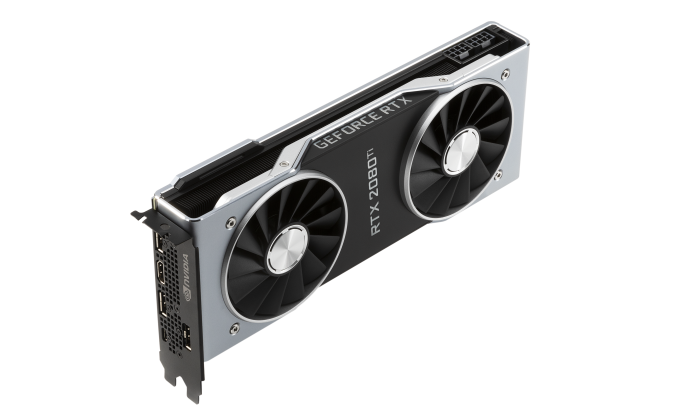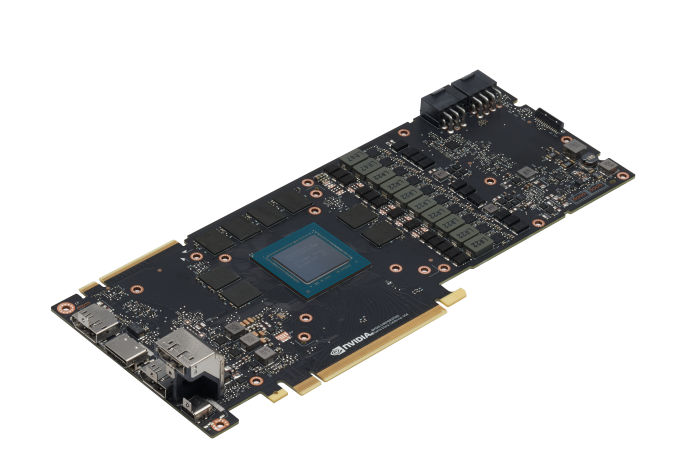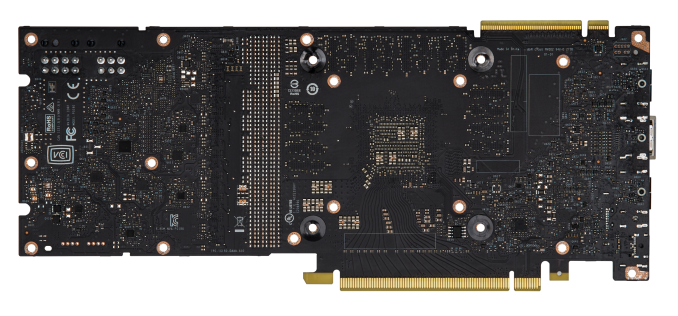The NVIDIA GeForce RTX 2080 Ti & RTX 2080 Founders Edition Review: Foundations For A Ray Traced Future
by Nate Oh on September 19, 2018 5:15 PM EST- Posted in
- GPUs
- Raytrace
- GeForce
- NVIDIA
- DirectX Raytracing
- Turing
- GeForce RTX
Meet The GeForce RTX 2080 Ti & RTX 2080 Founders Editions Cards
Moving onto the design of the cards, we've already mentioned the biggest change: a new open air cooler design. Along with the Founders Edition specification changes, the cards might be considered 'reference' in that they remain a first-party video card sold direct by NVIDIA, but strictly-speaking they are not because they no longer carry reference specifications.
Otherwise, NVIDIA's industrial design language prevails, and the RTX cards bring a sleek flattened aesthetic over the polygonal shroud of the 10 series. The silver shroud now encapsulates an integrated backplate, and in keeping with the presentation, the NVLink SLI connectors have a removable cover.
Internally, the dual 13-blade fans accompany a full-length vapor chamber and component baseplate, connected to a dual-slot aluminum finstack. Looking at improving efficiency and granular power control, the 260W RTX 2080 Ti Founders Edition features a 13-phase iMON DrMOS power subsystem with a dedicated 3-phase system for the 14 Gbps GDDR6, while the 225W RTX 2080 Founders Edition weighing in with 8-phases main and 2-phases memory.
As is typical with higher quality designs, NVIDIA is pushing overclocking, and for one that means a dual 8-pin PCIe power configuration for the 2080 Ti; on paper, this puts the maximum draw at 375W, though specifications-wise the TDP of the 2080 Ti Founders Edition against the 1080 Ti Founders Edition is only 10W higher. The RTX 2080 Founders Edition has the more drastic jump, however, with 8+6 pins and a 45W increase over the 1080's lone 8 pin and 180W TDP. Ultimately, it's a steady increase from the power-sipping GTX 980's 165W.
One of the more understated changes comes with the display outputs, which thanks to Turing's new display controller now features DisplayPort 1.4 and DSC support, the latter of which is part of the DP1.4 spec. The eye-catching addition is the VR-centric USB-C VirtualLink port, which also carries an associated 30W not included in the overall TDP.
Something to note is that this change in reference design, combined with the seemingly inherent low-volume nature of the Turing GPUs, cuts into an often overlooked but highly important aspect of GPU sales: big OEMs in the desktop and mobile space. Boutique system integrators will happily incorporate the pricier higher-end parts but from the OEM’s perspective, the GeForce RTX cards are not just priced into a new range beyond existing ones but also bringing higher TDPs and no longer equipped with blower-style coolers in its ‘reference’ implementation.
Given that OEMs often rely on the video card being fully self-exhausting because of a blower, it would certainly preclude a lot of drop-in replacements or upgrades – at least not without further testing. It would be hard to slot into the standard OEM product cycle at the necessary prices, not to mention the added difficulty in marketing. In that respect, there is definitely more to the GeForce RTX 20 series story, and it’s somewhat hard to see OEMs offering GeForce RTX cards. Or even the RT Cores themselves existing below the RTX 2070, just on basis of the raw performance needed for real time ray tracing effects at reasonable resolutions and playable framerates. So it will be very interesting to see how the rest of NVIDIA’s product stack unfolds.
















337 Comments
View All Comments
darkos - Friday, September 21, 2018 - link
Please add flight simulation testing to your list of applications. eg: X-Plane, Prepar3d.Vinny DePaul - Friday, September 21, 2018 - link
I am still rocking 980 with fps over 60 and everything turned up to max. I guess I will wait.mapesdhs - Thursday, September 27, 2018 - link
That's a perfect summary of why tom's looney article was so bad. If your current hw is doing just fine for the games you're playing atm, then upgrading makes no sense. It's rather cynical of NVIDIA, and some tech sites, to basically create a need and then push people into thinking they're idiots if they don't upgrade, while hiding behind very poor price/performance dynamics.DARK_BG - Friday, September 21, 2018 - link
As someone working in the game industry for already 8+ years I can tell you only one thing.No body will rush to implement proprietary features!The ones that have demos or are about soon to have the features implemented are the ones Nvidia reached to not vise versa.
This days making a game is no different than making any other product on this planet.It is corporate bussines which means you want maximum profit which translates in maximum user coverage which translates in maximum platforfm coverage PC (Windows , Mac , Linux), Consoles and mobile.
There is just no basis to anyhow compare Vulkan to anything proprietary.Vulkan is coming with the promise that what i make will look and feel the same way visually across multple platforms without requiring too much husstle on the development side.Even when you use a flexible engine as UE4 it is not that easy to have the same stuff working across multiple platforms and changes and further development for materials and meshes are required to have the stuff atleast to look indetical.
So i can hardly imagine that while you are bogged down with tons of bugs and trying to deliver your product across multiple platforms you will add yourself one more pain in the ass as nVidia Ray Tracing that will have doubfull income effect on your title given the small user reach.
I can give you Wargaming and Valve games as an example of old engines that are making tons of money.
So while nVidia is trying to ripoff people with that amount of money I'm wondering how to optimise one level so it could run fast and look cool on 6 years old midrange hardware.
eddman - Friday, September 21, 2018 - link
*off-topic*Although it is true that proprietary features do not always take off in a meaningful way (the GPU-accelerated mode of physx as an example), it doesn't mean an open standard would always be the popular choice.
Take big budget games from large publishers. These games, in the large majority of cases, are only available on three platforms, PS, xbox and windows, because these are the platforms that have the hardware to support such games and also have the largest audience.
IINM, vulkan is not available on X1 and PS4. If a AAA game dev was to use vulkan on windows, they'd still need to code the game for directx on X1 and GNM or GNMX on PS4, meaning they'd have to support three APIs.
If they go with directx on windows, then two platforms will already be covered and they'd only need to do additional coding for PS4 support.
On the other hand, vulkan does make sense for devs of smaller games where they want to cover as many platforms as possible, specially for mobile games, where vulkan covers windows, linux, mac, android and I think ios and even switch.
eva02langley - Friday, September 21, 2018 - link
Yes and no, for example Freesync is finally getting support from TV makers. Finally, I can get a 4k big screeen with HDR and... freesync.Open source is the way to go over proprietary technology.
eddman - Friday, September 21, 2018 - link
That's why I wrote it's not always the case. Sometimes it works, sometimes not. It all has to do with the standard having industry support. Being open source does not automatically mean it'd catch on, unfortunately.noone2 - Friday, September 21, 2018 - link
Someone will and it will be great and then it will catch on. Or maybe it won't, but that's how things happen. Someone takes a risk and it pans out. Either contribute to it or don't, play safe or take a chance.Nvidia has obviously been making some pretty good decisions over the years and has turned out some amazing products. Sometimes they've been wrong, but more often than not they are right. If they were wrong more than not, they'd be out of business, not a $150B company.
If you don't ever take a risk doing something new or cutting edge, you'll disappear. This is true for all technology.
noone2 - Friday, September 21, 2018 - link
Oh, and remember, at some point you don't have to care about 6 year old hardware. Look at consoles. At some point the studio just stops making a game for the last-gen, even though the new gen doesn't have the same size install base yet. Or a non-franchise game just shows up for next-gen and that's it. They never even bother to attempt to make it on older stuff.eva02langley - Friday, September 21, 2018 - link
Thanks for your comment, this was my argument all along.The only way to force a new feature is by shear numbers. Basically, if RTX was something available on new consoles, then that would make a business stand point sense, however AMD is owning consoles and might for a long term.
AMD should force multi-GPU via Infinity Fabric through consoles. This would work because devs would have access to additional power on the die via proper coding... and this delivered to 100% of the user base.
If this is only developed for less than 1% of the PC user base, this will fail miserably and nobody would add support unless sponsored by Nvidia themselves.
Financial analysts are seeing it and downgrades are coming.